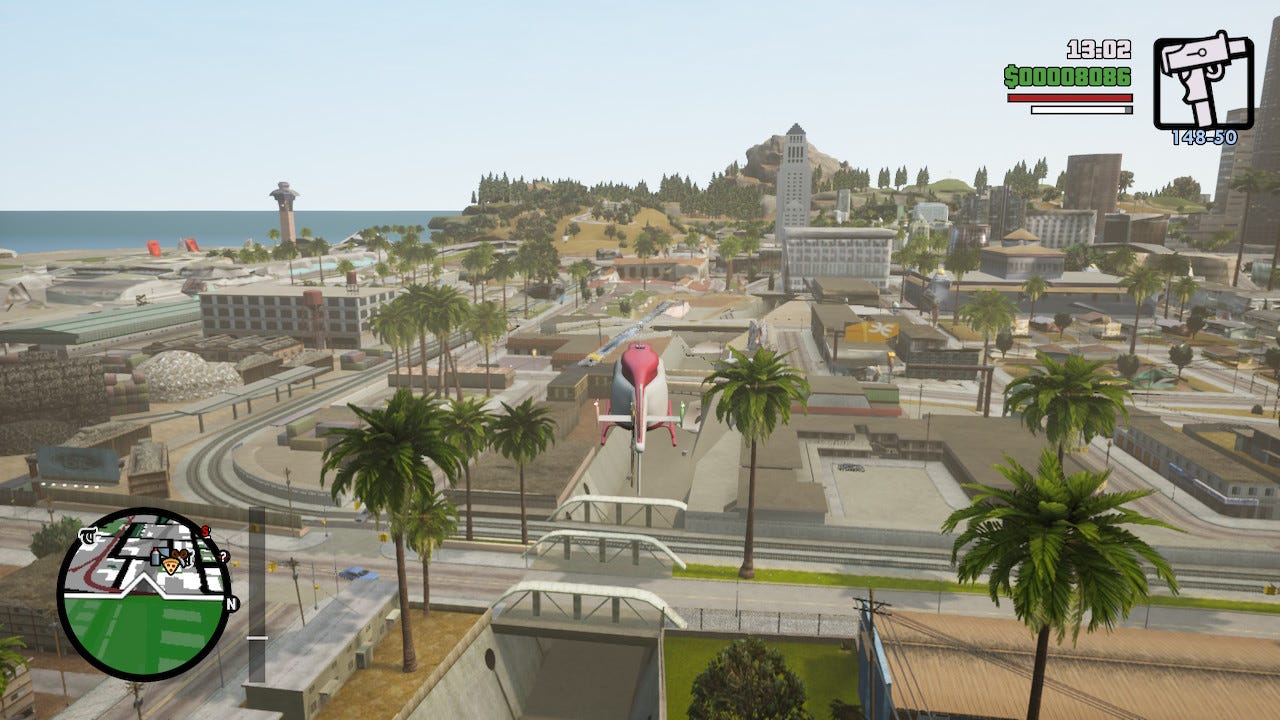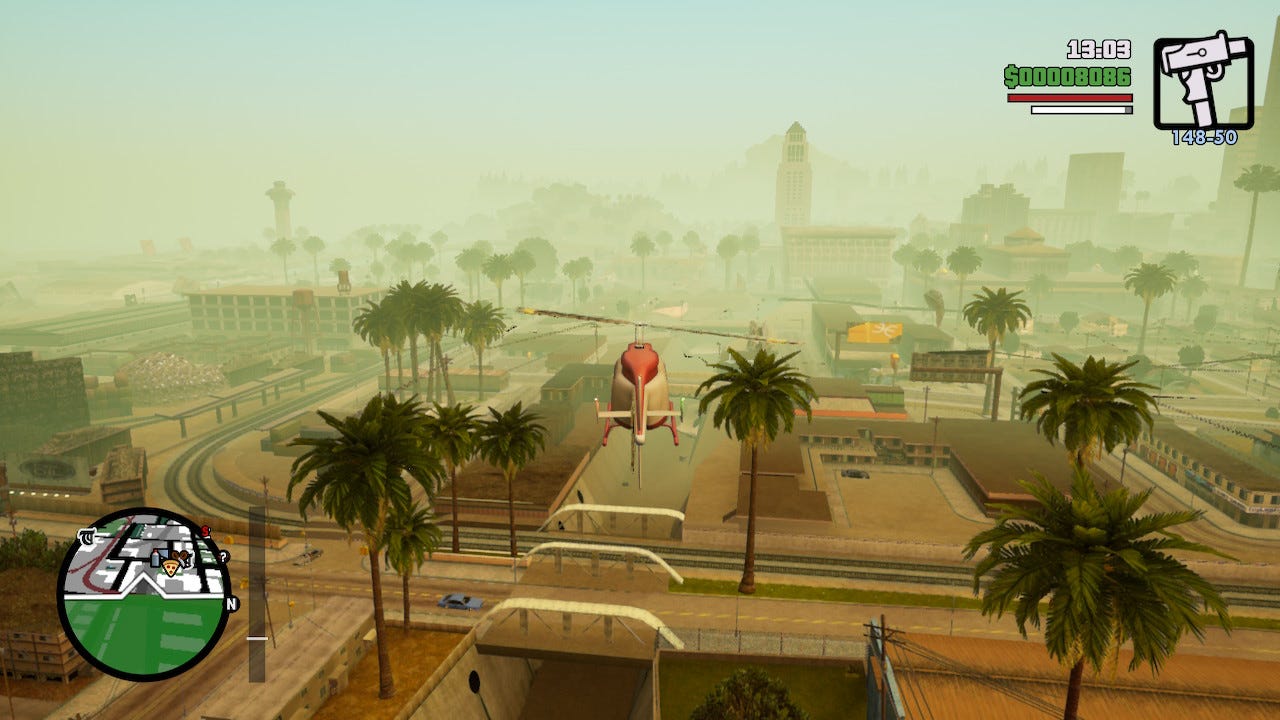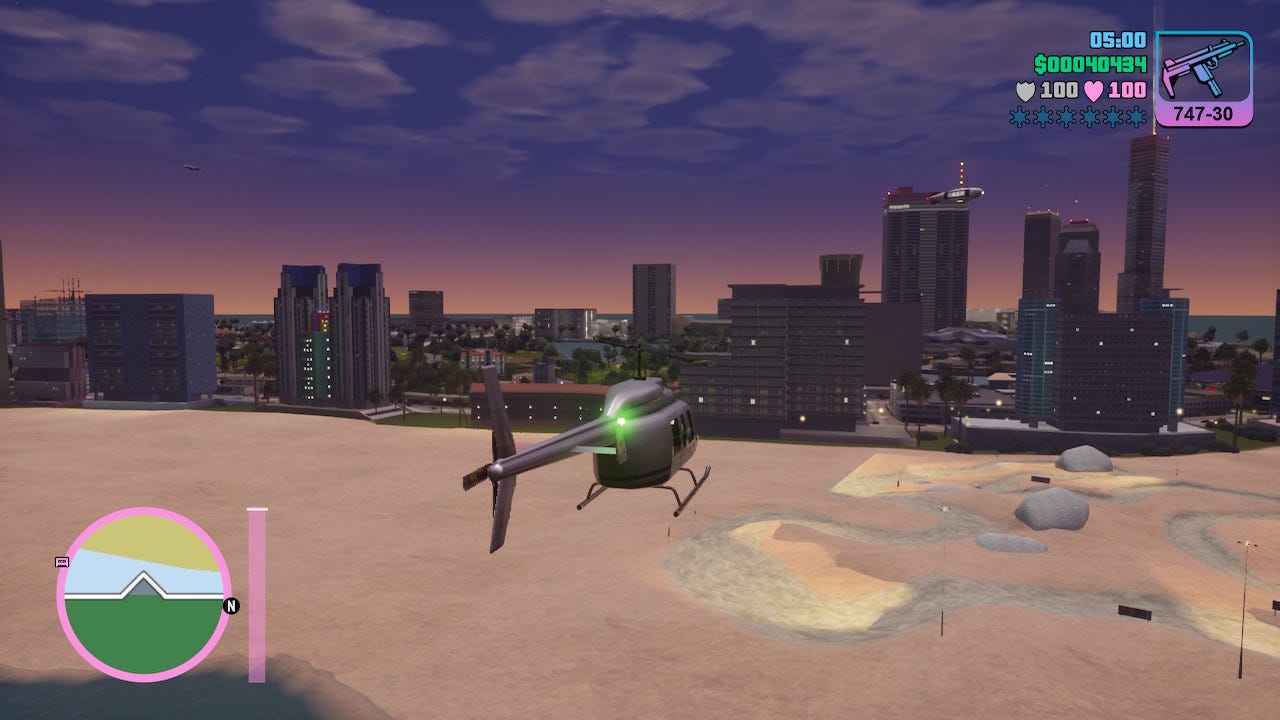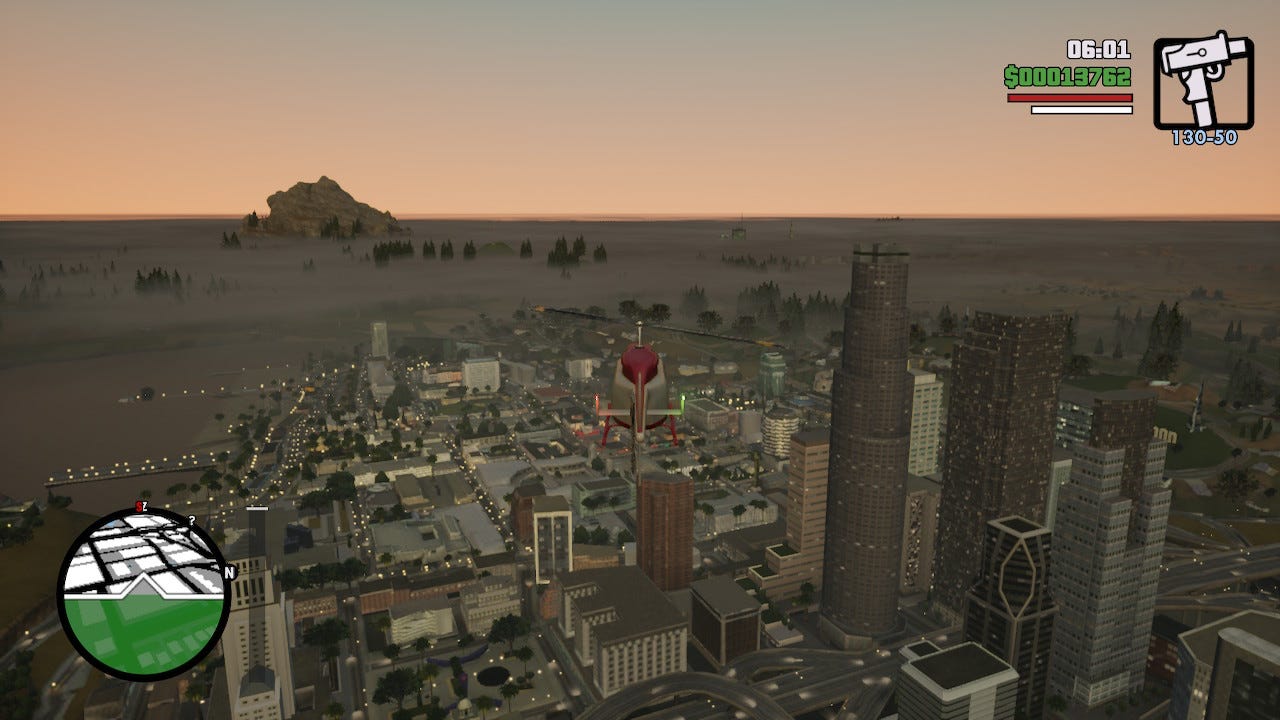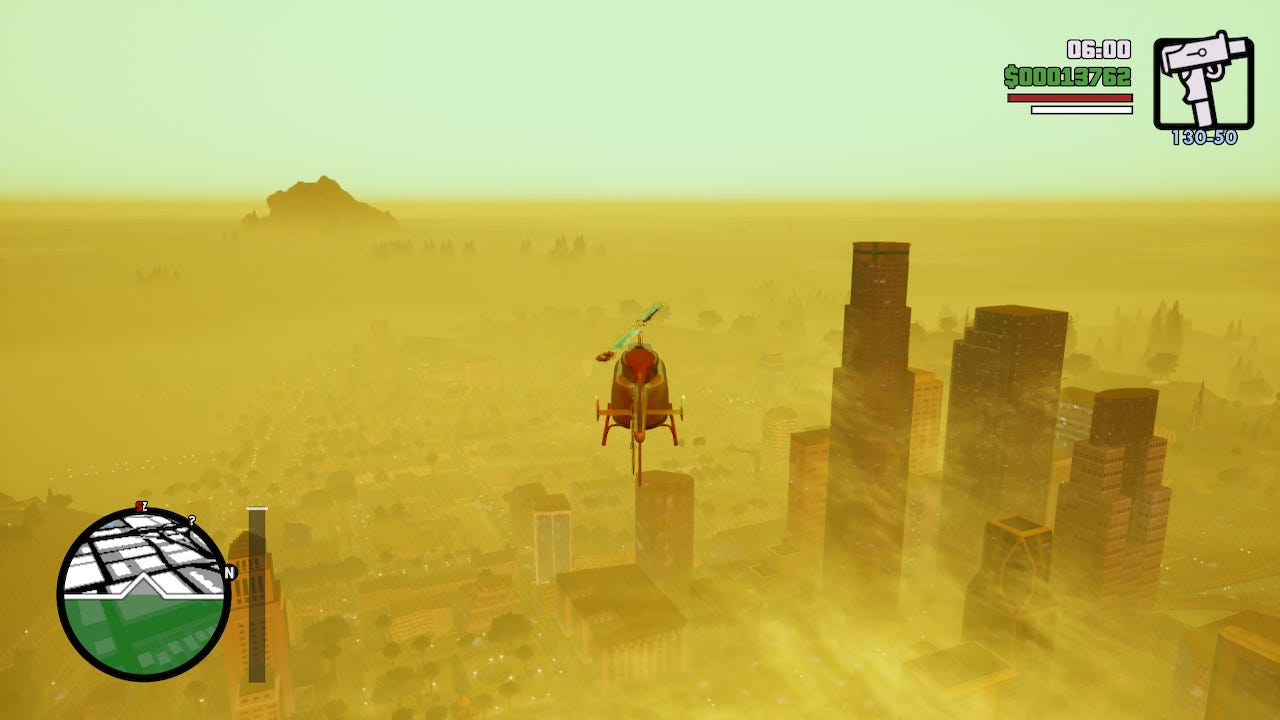The Light of Creation in Vice City and Los Santos 🌴
The new patch to the Grand Theft Auto trilogy had me asking the kind of questions that André Bazin might vibe with.
In Genesis, God does a whole slew of things that would ring familiar with any game designer. He creates life, the world, the seas, and the sky. All of that in lieu of the empty nothingness that it claims existed before.
But not only empty, but dark. And it was from this darkness that he made perhaps his most important creation in creating light, or rather, separating such light from the dark. For without light you could not discern any of his creations, much less his glory for creating them.
In a sense then, all things come from light. Light allows us to experience reality, which is why it comes before life in Genesis.
Video game developers are tasked with similar demands, to use light to render entire worlds and universes for the player to experience and play. Often times, like cinema, photography, and painting, this light resembles our own; a lot of the times it is like nothing we have ever seen.
But either way, like Genesis, it is there, and it is the imperative before all else. Light makes a game, and I’m going to prove that to you.
When the Grand Theft Auto The Trilogy released a few years ago, its use of light—and many other things—was fundamentally broken. From what I understand, the developers of the ‘remastered’ Trilogy (NOT Rockstar but Grove Street Games1) used one single sky-box for all three games, which rendered them under a boring sky and environment which attempted in vain to recreate reality.
The developers created a light that rendered the features of those worlds as ugly, bland, small, cramped, indiscriminate, and basically the negation of a vibe.
Which is a crime, as we shall soon see, because those original games were passionate experiments in light and color. Below is a screenshot of the game before the update:
This is supposed to be 1pm, but it looks as if could be any time of day; the sky is flat and boring, with literally nothing going on cloud or weather-wise. Every single LOD (level of detail) in the scene is visible, and there is no space whatsoever between background and foreground. Everything is squat and jumbled, all plastered on the screen.
This is what the same scene looks like with the patch:
Let there be light!
It is an entirely different image. The background, hazy and in the distance, is separated from the foreground, which allows the distinct palms of Los Santos to shine through. This feels like 1pm and it feels like LA. Instead of the overexposed nightmare of before where every color runs together in visual vomit, the colors the developers originally intended to be associated with Los Santos are fully present: the green-orange glow anyone whose played San Andreas would instantly recognize.
It’s a pretty dynamic difference.
Here is a shot of north Vice Point in Vice City before the update. This is supposed to be 5am; the sky has the ghoulishly bland-orange creeping light that it does every day, no exceptions (a similar one at dusk, too). Light should be exploding on the scene, as this image of Vice Point is facing directly against the rising sun. But there is no rising sun here, simply a Thomas Kinkade-like ‘dawn’ background. Also every single LOD is visible and similarly dark and unaffected by what should be the morning’s brilliant light.
This is scene after the patch:
Let there be light!
The difference is stunning. Here is dawn2, with the city completely soaked by those first golden rays of the sun as they wash over the island. The background is barely in view, although the city’s omnipresent blimp and two tallest structures loom in the mix of shadows and light. Whereas dawn in the first image is simply a mechanic, it is a phenomenon here.
Here is 30 minutes later on the south of the island in Washington Beach before the patch:
EVERYTHING is visible in this shot, even the towers of downtown which are one the almost exact opposite end of the map. In fact, by looking at this image you would never know that the two locations, Washington Beach and Downtown, are separated by water and Prawn Island. The lights of the infamous strip are meek and placid; It is a half-hour after the last image and the only change has been the ongoing mechanical expansion of the hideous orange morning background glow. The map’s lighting is basically already set to ‘day’ which just completely obliterates any sense of the uniqueness of the very early morning; it is less than two hours into daylight and EVERYTHING is already lit.
And this is probably the best looking of all the pre-patch images I will be showing you. But it will soon leave your mind’s eye forever when you see what the patch does:
Let there be light!
We have gone from a moderately OKAY view of Washington Beach to something entirely captivating: the lights of the strip are in contrast to the early morning brilliance, which cloaks the map in a morning haze which separates the foreground, the strip and helicopter, from the rest of the map. The two largest towers of Downtown loom imposingly with the last sliver of light from their roofs competes with the birth of the day, which looms both impressively and slightly menacingly over the city, both a promise and a threat.
THAT is Vice City for me.
Here is another pre-patch vision of Los Santos:
This is supposed to be 6am, one hour after dawn’s first light, and again here we are with the ugly orange that creeps in the background of the sky, but plays almost no part in the city’s illumination. Practically the entire city of Los Santos is visible, and it all looks like terrible, like a train model with a fog machine on top. That fog obscures San Fierro and most of Mount Chiliad, which are supposed to be in different areas of the state. But here they simply seem like they’re a town over, because even if you can’t see most of the low-lying San Fierro, you can see the entire contours of the map, which instantly destroys the idea that this, San Andreas, is a whole ass state.
With such lighting and scaling it really does truly feel like your playing action figure on a big basement train model of San Andreas, as opposed to the experience of being a person moving around a giant US state.
This is going to be immensely obvious when we see what the post-patch looks like:
Let there be light!
An entirely different image, and one that greatly fills out the rule of thirds, with the very tippy top of Mount Chiliad barely visible in one corner, and the skyline of downtown Los Santos peeping through the morning fog and smog in the inverse corner. So much mystery and excitement stews here, with the clouds blending into that smog, with most of Los Santos obscured. This is Los Santos, with any hint that San Fierro exists completely covered, which makes it then feel really far when you do catch it when heading further west.
Again, like Vice City, morning has turned from a boring and habitual mechanic into an event.
Let’s switch it up now and see what has happened to the night time. This is a pre-patch image of 1:30am somewhere around Fort Carlson:
Compared to most of the previous pre-patch images, this one isn’t inherently the worst, even if it is a bit boring. The night sky is dark—Genesis-level dark—with little to no light emanating from the stars or from the (incredibly lit) Las Venturas; the foreground isn’t terrible, with some vegetation helping frame the shot, and we can see the red from the tail lights and the yellow from the headlights adding some, not much, additional light.
Let us now see what it looks like after the patch:
Let there be light!
Even at night, there is light and color.
The sky is still dark, but it is dark in layers, and it is dark with color, as the darker top of the sky blends seamlessly into the blue of late-night. There are the same amount of stars, but with the blue of the lower-horizon they become much more visible, as is the foreground, which only begrudging existed before, is now clearly outlined, with no hint of Las Venturas in the background. This has the effect of opening up the sky, which contrasts sharply with the ground, an effort which was rather meek in the previous shot. The ground is the faded yellow it was meant to be, yet it still feels as if it is shrouded completely in the dark wash of night.
One last example, this time from Vice City again:
A wash out! Color seemingly doesn’t exist in this image save for the pink ring of the mini-map and the yellow outfit of the woman immediately in the foreground. The developers (Grove Street Games) were attempting realism, but this scene does not look like anything we actually experience in life; I, for one, have never seen a background faded like there is celofane smothering it. And the foreground is so bland, nothing minus the lower-left has almost any color, and my beautiful Sentinel leaving almost no impression, and remember this is the player’s sprite. The foreground is ugly, the background is ugly, and neither look like they belong in the same image.
Let’s see what it looks like with light and color:
Let there be light!
Oof, the difference is obvious and painful. Color! A foreground and a background seamless together! My beautiful Sentinel shimmers in the morning light, as the women’s yellow swim wear matches—but is distinct—from the orange hue of the background, which brings the whole image together color-wise and with the proper depth-of-view. The sun here is a feature, not simply a fact, like it was in the previous image. Downtown is bathed in that sun’s morning glow, and the city’s iconic palm trees—like Los Santos—are clear and visible, and the tallest buildings of downtown only just peep through the whole scene, framing it perfectly.
This, while being the more aesthetic of the two, is significantly closer to the real-world, because the real world is aesthetic. Reality, thanks to light, runs all kinds of colors and temperatures, with human vision playing all kinds of marvelous tricks on our depth-of-view and field-of-vision.
And more to the point, these games were always meant to be aesthetic. The developers, breaking ground game-after-game with the open-world genre, were also constrained by the period’s technical abilities, and like all the great auteurs of ancient Hollywood, they made magic out of dust.
Light and color and depth-of-vision do so much in framing the player’s view, which was necessary to create the illusion that a. these maps and cities were huge, like reality, and b. that the player is constrained visually by time-of-day and perspective; even when standing atop Mount Tabor3, my view of the surrounding city, Portland, is entirely dependent upon these same factors. Humans don’t get to see everything all the time, and neither does Tommy Vercetti or Carl Johnson.
This is the last image I will talk about.
One of the primary advantages to the new patch, is that it has made flying fun, and, most importantly, a vibe, again. The clouds—which didn’t exist in the pre-patch—are full and they hang and hover over the land before, which cloaks the map and gives the sense that one is traveling quite impressive distances, ie flying around California. This image shows how the map’s three major cities, Los Santos, San Fierro, and Las Venturas, are separated by the color and draw distance: Los Santos on the approach from Las Venturas, which is in the desert, feels appropriately far away to be guarded by a massive red wood and pine forest. The distance, really only a bridge and smallish stretch of road, feels miles and miles and miles apart, with just a hint of Los Santos’ Downtown in the very back of the background; in the pre-patch most of the city if not all of it would have been visible from the same distance. Here the forest and sky stretch across the frame to surround and envelope my Dodo4 for the vibest of vibes.
All of it reminds me deeply of the first few decades of cinema, where the silent and early sound pioneers, lacking the noise and color of reality, focused almost exclusively on light; the director Josef Von Sternberg once told his muse Marlene Dietrich that her motivation for the scene was one of the set lights, which he told her to equate with God. André Bazin wrote something not dissimilar, although knowing Bazin he might have preferred the pre-patch version for its limitless depth-of-field. But Bazin’s contention that the film image represented something akin to a religious experience can be used by those of us happily without the faith; the image itself becomes the faith.
And what bothers me most is that I didn’t quite notice how bad the pre-patch version was, as I had already been clocking in many hours on both Vice City and San Andreas pre-update. In my defense, I had not played any of Grand Theft Auto original trilogy (of which I am staunchly including the fantastic Vice City Stories and Liberty City Stories) since the Bush administration, and my mind, as it often does, tried to hang its hat on what I was presented, ie the pre-patch lighting and (lack of) color. It looked OKAY only if one excludes completely what it should look like.
And even these newly-patched products seem to be Rockstar reckoning with what Grove Street Games had already created, and while I think all three look fantastic now, they still don’t look quite as good as the originals, even with the updated graphics. Those games were first and foremost an aesthetic experience, one in which the limitations of the programs and hardware were turned inward to create, well, an eternal vibe.
And right now, I, like many people, need a vibe. Even before the patch, these three games were doing much emotional lifting, as Vice City makes me nostalgic for my childhood and adolescence in South Florida, while GTA III does the same for my time in New York, and San Andreas helps me understand my new home of the West Coast.
But with the new patches? Baby, they’re a fucking vibe!
It’s amazing to me that at this stage Rockstar would contract out work when the studio itself is swimming in the endless flow of profits from V and Online.
Vice City’s dawn light begins around 4am, where it is 5am for San Andreas.
Portland’s Mount Chiliad.
More accurately, property of San Fierro International.





